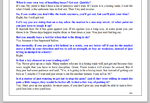darktone
Veteren member
- Messages
- 4,019
- Likes
- 1,086
Okiemadokie. Been on my mind a bit of late to do a thread on trading using a very simple method. So here i am.. Committed! lol
Its with trend using a single 10ema. It can be used in any timeframe but ill be using two timeframes for most part, the larger one for trend id and smaller one for taking and managing the initial position. Limit orders will be used to take profit / loss for the most part. The main focus of which will be to keep losses (there will be many) as small as poss.
Theres a couple of things that many of you might find appealing or appalling depending on your view. Stops, arnt used for the most part in the traditional manner, the word 'hope' might well appear, as will "I dont know!". Theres no prediction in the normal sense, for me personally this is great because it frees me up emotionally to focus on what I think is most important part, which is to manage losses. Its also takes ego out of the equation!
The above is offered up mostly for the beginners but is open to all to offer views for or against, ask questions etc. Lets try and keep it sensible folks though eh, no need for cryptics or s**t slinging.
Defining the trend: (see attached)
Up trend = closing above ma. Down trend = closing below ma.
Method:
1) Signal to buy/sell is first close above/below the MA.
2) Use a limit to enter.
3) Use a limit to take a profit.
4) Use a limit (not a stop!) to take an initial loss. Ie Youve positioned and the trend changes. Use a break even or + 'x' ticks/points stop when it starts to run to your profit limit.
Something i forgot to mention earlier. Trading with limits is Broker/Spreadbet friendly as its far easier for them to hedge you it you are profitable. Youre far less likely to receive 'special attention' if you trade less, with limits, imho.
Cheers
D
Its with trend using a single 10ema. It can be used in any timeframe but ill be using two timeframes for most part, the larger one for trend id and smaller one for taking and managing the initial position. Limit orders will be used to take profit / loss for the most part. The main focus of which will be to keep losses (there will be many) as small as poss.
Theres a couple of things that many of you might find appealing or appalling depending on your view. Stops, arnt used for the most part in the traditional manner, the word 'hope' might well appear, as will "I dont know!". Theres no prediction in the normal sense, for me personally this is great because it frees me up emotionally to focus on what I think is most important part, which is to manage losses. Its also takes ego out of the equation!
The above is offered up mostly for the beginners but is open to all to offer views for or against, ask questions etc. Lets try and keep it sensible folks though eh, no need for cryptics or s**t slinging.
Defining the trend: (see attached)
Up trend = closing above ma. Down trend = closing below ma.
Method:
1) Signal to buy/sell is first close above/below the MA.
2) Use a limit to enter.
3) Use a limit to take a profit.
4) Use a limit (not a stop!) to take an initial loss. Ie Youve positioned and the trend changes. Use a break even or + 'x' ticks/points stop when it starts to run to your profit limit.
Something i forgot to mention earlier. Trading with limits is Broker/Spreadbet friendly as its far easier for them to hedge you it you are profitable. Youre far less likely to receive 'special attention' if you trade less, with limits, imho.
Cheers
D
Attachments
Last edited:






